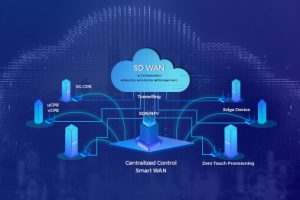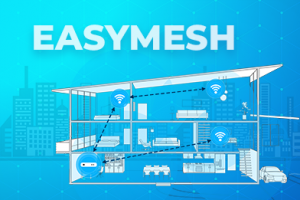In today’s digital world, a seamless and fast internet connection is no longer a luxury, it’s a lifeline. From 8K video streaming, cloud gaming, and real-time video conferencing to smart home ecosystems and business-critical cloud applications, users expect flawless performance. As the number of connected devices grows and traffic types diversify, managing bandwidth efficiently becomes increasingly complex.
Traditionally, networks relied on Quality of Service (QoS) techniques to manage and prioritize internet traffic. These static, rule-based systems worked in simpler network environments but often fall short in today’s dynamic, high-density scenarios. They lack the intelligence to adapt to real-time changes, ignore encrypted or untagged traffic, and require manual configuration.
Enter Wi-Fi 7, the latest wireless standard built for high throughput, low latency, and next-gen applications and when combined with AI-powered traffic intelligence, it doesn’t just manage traffic, it understands it. Together, Wi-Fi 7 and AI are ushering in a new era of self-optimizing, high-performance wireless networks that think on their feet. Let’s explore how this combination is redefining traffic prioritization beyond the limitations of traditional QoS.
Table of Contents
Understanding QoS and Its Limitations
Quality of Service (QoS) is a network feature that helps prioritize certain types of data to ensure smooth performance for critical applications. It works by assigning priority levels to different types of traffic, such as giving video calls higher priority over file downloads.
However, QoS has several limitations:
- Manual Configuration: Traditional QoS requires network administrators to manually define traffic rules, which can be complex and time-consuming.
- Static Prioritization: Once set, QoS rules do not adapt in real time to changing network conditions.
- Limited Context Awareness: QoS does not analyze user behavior and application needs dynamically.
- Inefficiency in High-Density Environments: With multiple devices connected, fixed QoS rules may not always allocate bandwidth effectively.
How AI-Powered Wi-Fi 7 Enhances Traffic Prioritization
Wi-Fi 7 introduces significant improvements in speed, latency, and bandwidth. When combined with AI-driven network intelligence, it transforms traffic management by making it smarter, more adaptive, and automated. Here’s how:
1. Smarter Traffic Classification with AI
Traditional traffic prioritization relies on established QoS techniques:
- 802.1p (IEEE 802.1Q standard) uses VLAN tags with priority levels (0-7) to classify Layer 2 Ethernet traffic.
- DSCP (Differentiated Services Code Point) in the IP header assigns priority levels for Layer 3 traffic but is often ignored by cloud services and applications.
- IEEE 802.11e WMM QoS categorizes Wi-Fi traffic into four access categories:
- Voice – Highest priority
- Video – High priority
- Best Effort – Normal priority
- Background – Lowest priority
The AI-powered traffic classifier in Wi-Fi 7 goes beyond these traditional approaches by dynamically analyzing traffic patterns in real-time. This ensures that prioritization is not solely dependent on static DSCP values, which are often ignored in cloud environments.
2. AI-Driven Dynamic Traffic Optimization
AI-powered Wi-Fi 7 eliminates the shortcomings of traditional QoS by continuously adapting to real-time network conditions.
- Detects Traffic Types Automatically: AI identifies whether data packets belong to a video call, gaming session, or background download without relying solely on DSCP markings.
- Prioritize Traffic Intelligently: Instead of static rules, AI dynamically adjusts traffic categories based on congestion, device type, and application sensitivity.
The Future of AI-Powered Wi-Fi 7: Smart, Self-Optimizing Networks
The combination of AI-driven automation and Wi-Fi 7’s multi-link operation (MLO) is redefining network traffic management. Users no longer need to manually configure settings or suffer from network slowdowns due to outdated prioritization methods. AI-powered networking delivers:
- Faster and more reliable connectivity with MLO
- Optimized traffic classification for an enhanced user experience
With AI-driven network intelligence, Wi-Fi 7 is no longer just about speed, it’s about real-time decision-making, seamless automation, and superior efficiency. As IoT adoption, smart homes, and hybrid work models continue to grow, AI-powered Wi-Fi 7 ensures networks remain agile and future-ready.
Summary
Traditional QoS methods were built for a simpler time, but today’s networks demand adaptive, intelligent prioritization. AI-powered Wi-Fi 7 is a game-changer, eliminating static traffic rules and replacing them with AI-driven, self-optimizing networks that anticipate and respond to user needs in real time.The future of wireless networking isn’t just faster—it’s smarter, adaptive, and AI-powered.
Experience VVDN’s AI-Powered Wi-Fi 7 Solutions
Looking to integrate an AI-powered Wi-Fi 7 Access Point into your product lineup? VVDN offers white-label solution, reference design, and full support for customization and mass production—tailored specifically for OEMs, Telcos, ISPs, TSPs, and Operators. Whether you need a ready-to-brand product or a fully customized solution, VVDN enables you to accelerate time-to-market and deliver next-gen connectivity to your customers. Get in touch today!
Accelerate your AI-powered Wi-Fi 7 Access Point development with VVDN. Connect with us at info@vvdntech.in
































